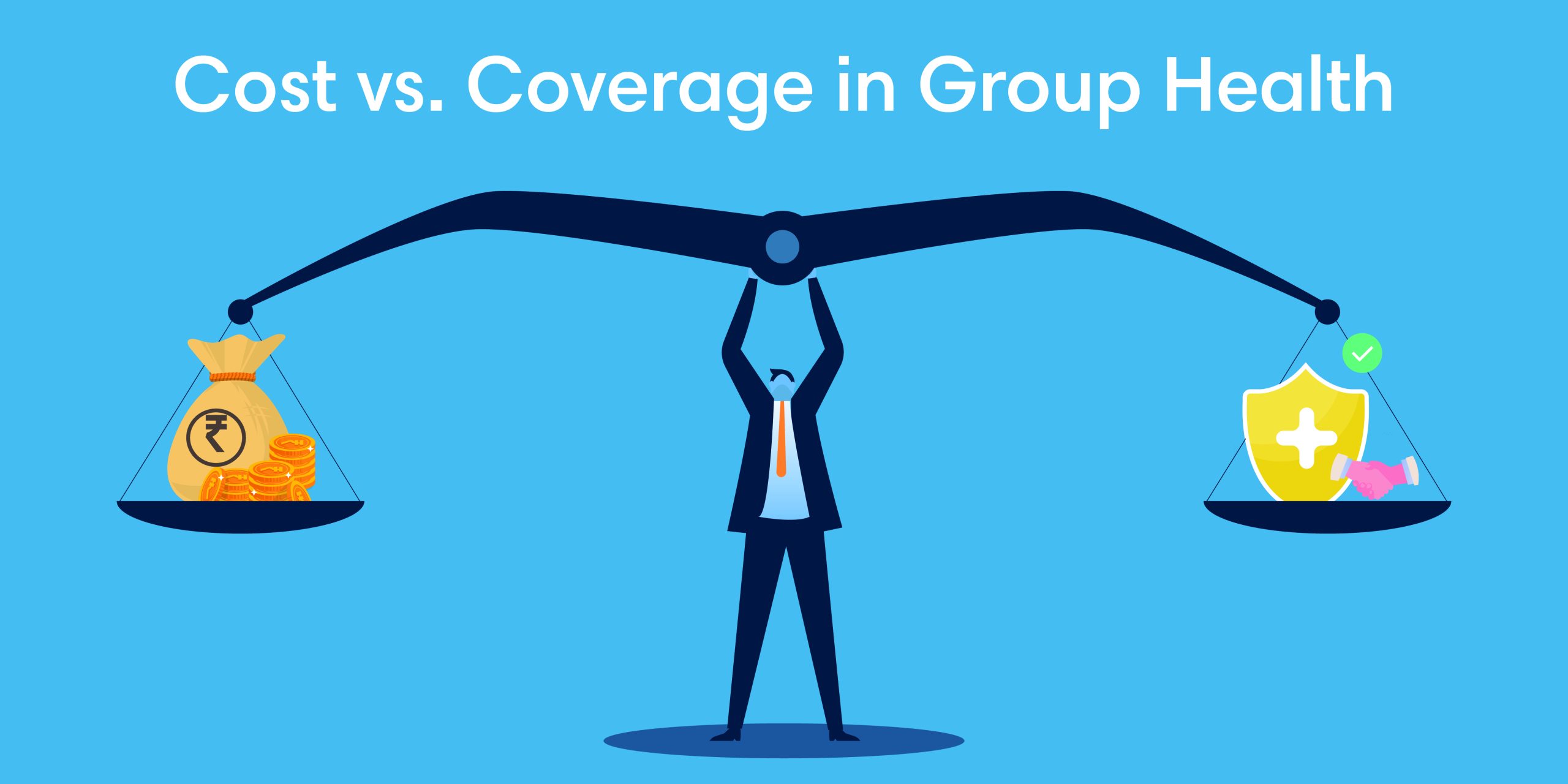
Group health insurance is a type of health coverage an employer provides to its employees and, often, their families. This collective health insurance policyAn insurance policy is a legally binding contract between an insurance company (insurer) and an individual or business (policyholder). It More offers multiple benefits, such as lower premiums, wider coverage, and simplified administrative processes compared to individual health insurance plans. By pooling risks among a larger group, group health insurance makes healthcare more accessible and affordable for employees.
Balancing cost and coverage in group health insurance is crucial for employers and employees. For employers, managing the cost of health insurance is essential to maintain financial stability and profitability. Offering comprehensive coverage, however, is equally necessary to ensure the well-being and satisfaction of employees, which can lead to higher productivity and retention rates. Striking the right balance ensures that the health insurance plan is economically feasible for the employer and sufficiently beneficial for the employees.
In this blog, we’re diving into the nitty-gritty of group health insurance plans—specifically, how costs and coverage play off each other. We’ll explain what factors mess with these trade-offs, how to juggle them wisely, and why it’s a big deal for bosses and workers. It’s all about finding that sweet spot where everyone gets good coverage without breaking the bank. Ready to crack the code? Let’s roll!
Table of Contents
1. What is Group Health Insurance?
Group health insurance provides health coverage to a group of people, such as employees of a company or members of an organization. Key features include:
- Employer-Sponsored: Employers choose the plan and share premium costs with employees.
- Uniform Coverage: All members get the same benefits and terms.
- Lower Premiums: Risk is spread over a larger group, resulting in lower premiums.
- Simplified Enrollment: Streamlined processes reduce administrative tasks.
- Open Enrollment Periods: Specific times of the year for employees to sign up or make changes.
For a detailed explanation, please refer to our comprehensive blog on this topic here.
Benefits of Group Health Insurance for Employers and Employees
Group health insurance offers numerous benefits for both employers and employees alike:
| For Employers | For Employees |
| Attracts high-quality employees, reduces turnover | Lower premiums, better coverage than individual plans |
| Tax-deductible premium contributions | Access to various services, including preventative care and prescription drug coverage |
| Healthier employees, more productive, lower absenteeism | Options to cover employees’ families, providing peace of mind and financial protection |
| Demonstrates commitment to employee well-being, fostering positive workplace culture | Coverage for pre-existing conditions, offering broader protection |
How Group Health Insurance Plans are Typically Structured
Group health insurance plans vary, but they generally follow a similar structure:
- Plan Selection: Employers select one or more health insurance plans from an insurance provider. Plans may include options such as Health Maintenance Organizations (HMOs), Preferred Provider Organizations (PPOs), and High-Deductible Health Plans (HDHPs), which are often paired with Health Savings Accounts (HSAs).
- Premium Sharing: Employers and employees share the cost of premiums. Employers often cover a significant portion, with employees paying the remaining amount through payroll deductions.
- Coverage Options: Plans offer a range of coverage options, including:
- Medical Services: Visits to doctors, hospital stays, surgeries, and specialist care.
- Preventative Care: Routine check-ups, vaccinations, and screenings.
- Prescription Drugs: Coverage for prescribed medications.
- Additional Benefits: May include dental, vision, mental health services, and wellness programs.
- Enrollment Periods: Employees can enrol in or change their plans during the open enrollment period or after qualifying life events such as marriage, the birth of a child, or loss of other coverage.
- Cost Sharing: Besides premiums, employees may pay deductibles, copayments, and coinsurance. These out-of-pocket costs vary depending on the plan.
By understanding group health insurance’s definition, benefits, and structure, employers and employees can better navigate their options and make informed decisions that effectively balance cost and coverage.
2. The Importance of Cost in Group Health Insurance
Understanding the importance of cost in group health insurance is crucial for businesses aiming to balance financial responsibility with providing valuable benefits to their employees:
Premium Costs
Premiums are the monthly fees to keep the health insurance policyAn insurance policy is a legally binding contract between an insurance company (insurer) and an individual or business (policyholder). It More active. Both employers and employees typically share these costs. Several factors influence the total premium cost:
- Group Size: Larger groups often receive lower per-person premiums due to risk spreading.
- Demographics: Age, gender, and health status of the group members can impact premiums.
- Coverage Level: More comprehensive plans with lower deductibles and more extensive benefits usually have higher premiums.
- Location: Regional healthcare costs and regulations can affect premium rates.
- Insurance Provider: Depending on network agreements and administrative costsCosts related to the operations of the health insurance. This included costs incurred in marketing the scheme, in premium collection, More, providers may offer varying rates for similar coverage.
Additional Costs: Deductibles, Copayments, and Coinsurance
Navigating a health insurance plan involves understanding more than just premiums. Deductibles, copayments, and coinsurance play crucial roles in determining your overall healthcare expenses:
| Term | Definition | Impact |
| Deductibles | Amount paid out-of-pocket before insurance coverage begins | Higher deductibles: lower premiums, higher initial costs |
| Copayments | Fixed amounts paid for specific services at time of service | Manages upfront costs, accumulates over time |
| Coinsurance | Percentage of costs paid by employee after meeting deductible | Shares cost burden post-deductible |
Impact of Cost on Small Businesses vs. Large Corporations
Understanding the impact of costs on small businesses versus large corporations requires a nuanced examination of their financial dynamics and operational strategies:
| Aspect | Small Businesses | Large Corporations |
| Premiums | Higher per-person | Lower per-person |
| Bargaining Power | Limited leverage | Greater leverage |
| Budget Impact | Significant financial impact | Better cost absorption |
| Retention | Challenging with limited budget | Can offer diverse plans |
| Financial Flexibility | Less flexibility | Greater flexibility |
Strategies for Managing and Reducing Health Insurance Costs for Employers
Implementing effective strategies to control and minimise health insurance expenses is crucial for sustaining financial health and employee satisfaction. By adopting proactive measures and leveraging innovative solutions, employers can navigate these challenges successfully:
For Small Businesses
Pool resources with other small businesses to gain better rates. Pair with Health Savings Accounts (HSAs) to lower premiums. Encourage healthy behaviours to reduce overall healthcare costs. Leverage expertise to find the best insurance options and negotiate rates.
For Large Corporations
Assume the financial risk of providing health benefits directly, often with stop-loss insurance for high claims. Focus on managing chronic conditions to reduce long-term costs. Provide primary care services at the workplace to lower external medical expenses. Offer virtual healthcare services to reduce the need for in-person visits and associated costs.
For All Employers
Assess and adjust plans regularly to ensure cost-effectiveness and relevance to employee needs. Help employees understand how to use their benefits effectively, reducing unnecessary expenses. Allow employees to use pre-tax dollars for medical expenses, lowering taxable income for employees and employers.
By understanding and managing these cost elements, employers can balance maintaining affordable premiums and providing valuable health coverage to their employees.
3. The Role of Coverage in Group Health Insurance
Coverage in group health insurance is crucial in shaping healthcare benefits for employees and their families. It forms the cornerstone of effective risk management and equitable access to medical services across diverse workforce demographics.
What Coverage Includes
Coverage extends to a wide range of essential services and protections, ensuring comprehensive support in various scenarios:

Medical Services
- Primary Care Visits: Regular check-ups, preventive screenings, and treatment for common illnesses.
- Specialist Care: Visits to cardiologists, dermatologists, and orthopedists for specific health issues.
- Hospitalisation: Coverage for in-patient care, surgeries, and emergency room visits.
- Outpatient Care: Services such as lab tests, imaging, and minor surgical procedures that don’t require an overnight stay.
Prescription Drugs
- Formulary Medications: A list of covered drugs, often categorised by tiers determining the copayment or coinsurance required.
- Generic vs. Brand-Name Drugs: Encouragement of generic drug use to manage costs, with varying levels of coverage for brand-name medications.
Preventive Care
- Routine Screenings: Mammograms, colonoscopies, blood pressure checks, and cholesterol tests.
- Vaccinations: Immunizations for diseases like influenza, HPV, and hepatitis.
- Wellness Programs: Initiatives that promote healthy living, such as smoking cessation programs, weight management, and fitness incentives.
Additional Services
- Mental Health Services: Counseling, therapy sessions, and psychiatric care.
- Rehabilitation: Physical therapy, occupational therapy, and rehabilitation services following an injury or surgery.
- Vision and Dental Care: Coverage for eye exams, glasses, dental check-ups, and orthodontics, though these may sometimes be offered as separate plans.
Importance of Comprehensive Coverage for Employee Health and Well-Being
Ensuring comprehensive coverage for employee health and well-being is a priority and a cornerstone of our commitment to fostering a supportive workplace environment. From robust medical benefits to mental health resources, our approach encompasses every aspect of employee wellness. Now, let’s delve into why this holistic approach is crucial for both our team members and our organisation as a whole:
Early Detection and Treatment
Comprehensive coverage ensures access to preventive care, which can lead to early detection and treatment of health issues, reducing the severity and cost of long-term care.
Chronic Disease Management
Adequate coverage for chronic conditions like diabetes, hypertension, and asthma helps employees manage their health effectively, reducing absenteeism and increasing productivity.
Mental Health and Well-Being
Access to mental health services supports employees’ overall well-being, helping them manage stress, anxiety, and other mental health issues that can impact work performance.
Financial Security
Comprehensive health coverage protects employees from high medical costs, provides financial stability, and reduces the stress associated with medical expenses.
Impact of Coverage on Employee Satisfaction and Retention
Examining the profound influence of coverage on employee satisfaction and retention reveals critical insights into organisational dynamics and workforce dynamics:
Job Satisfaction
Employees who feel their health needs are met through comprehensive insurance are more likely to be satisfied with their jobs, leading to higher morale and engagement.
Retention Rates
Offering robust health insurance plans can significantly enhance employee retention. Workers are less likely to leave a company that provides them with strong health benefits, reducing turnover costs.
Attracting Talent
Competitive health benefits are a key factor in attracting top talent. Prospective employees often consider the quality of health insurance when evaluating job offers.

Examples of Essential vs. Non-Essential Coverage Options
Next, we will examine examples of essential and non-essential coverage options:
| Coverage Type | Examples |
|---|---|
| Primary and Preventive Care | Maintains overall health, catches issues early |
| Emergency Services | For unexpected health crises |
| Prescription Drugs | Treats various medical conditions |
| Hospitalisation | For severe illnesses and surgeries |
| Mental Health Services | Critical to overall health |
| Coverage Type | Examples |
|---|---|
| Cosmetic Procedures | Aesthetic treatments and surgeries |
| Elective Surgeries | Non-urgent, quality of life procedures |
| Alternative Therapies | Acupuncture, chiropractic, homeopathy |
| Luxury Wellness Programs | Spa treatments, specialized fitness |
Balancing essential and non-essential coverage options allows employers to offer valuable health benefits while managing costs effectively. Employers can support employee health and well-being by focusing on comprehensive and necessary services, leading to a more satisfied and productive workforce.
4. Balancing Cost and Coverage
In navigating the complexities of healthcare, achieving a balance between cost-effectiveness and comprehensive coverage is paramount. Finding this equilibrium ensures optimal healthcare outcomes for all stakeholders involved:
Factors to Consider When Choosing Between Cost and Coverage
When deciding between cost and coverage, weighing several factors to ensure your choice aligns with your needs and financial goals is crucial. Here’s how to navigate this decision wisely:
Size and Needs of the Employee Group
Larger groups may have more bargaining power and can spread risk across more individuals, often resulting in lower per-person costs. Consider employees’ age, family status, and health needs. Younger, healthier employees might prefer lower premiums with higher deductibles, while older employees or those with families might value more comprehensive coverage. Survey employees to understand their priorities: whether they prefer lower premiums, extensive coverage, or specific benefits such as dental or vision insurance.
Financial Health of the Company
Assess the company’s budget for health insurance. A financially healthy company might afford to provide more comprehensive plans, while companies with tighter budgets may need to opt for cost-saving measures. Health insurance should be considered an investment in employee well-being, which can lead to higher productivity and lower absenteeism. Balancing immediate costs with long-term benefits is crucial.
Employee Health Risks and Demographics
If a significant portion of the workforce has chronic conditions, comprehensive coverage for ongoing care and medications becomes essential. Younger employees might prioritise different benefits than older employees, who may require more extensive medical services and prescription coverage. High-risk jobs may necessitate more robust health plans with comprehensive medical and emergency coverage.
Potential Pitfalls of Prioritizing Cost Over Coverage and Vice Versa
When navigating the complexities of insurance choices, striking the right balance between cost and coverage is crucial. However, overlooking one in favour of the other can lead to significant challenges down the road:
| Prioritizing Cost Over Coverage | Prioritizing Coverage Over Cost |
|---|---|
| Employee dissatisfaction and high turnover | Strain on company budget |
| Higher long-term costs from untreated conditions | Overuse of healthcare services |
| Difficulty attracting top talent | Reduced competitiveness due to high costs |
Balancing cost and coverage in group health insurance is complex but essential. Employers can create a plan that maximises benefits while maintaining financial sustainability by considering the unique needs of the employee group, the company’s financial health, and employee health risks. Successful case studies demonstrate that thoughtful strategies and employee-centric approaches can effectively achieve this balance.
5. Cost-Effective Strategies for Enhancing Coverage
Increasing coverage through cost-effective strategies requires thoughtful planning and resource allocation. Organisations can achieve broader reach and impact across diverse communities by exploring innovative approaches and leveraging existing infrastructure. Now, let’s delve into some practical methods for achieving these goals:
Wellness Programs and Preventive Care Initiatives
Implementing effective Wellness Programs and Preventive Care Initiatives is crucial for promoting employee health and productivity:
Wellness Programs
Regular health check-ups, blood pressure monitoring, and cholesterol screenings help detect health issues early. To encourage physical activity, you can subsidise gym memberships, offer fitness classes, or set up on-site fitness centres. Provide resources and support to help employees quit smoking, reducing health risks and associated costs. Offer workshops and consultations with dietitians to promote healthy eating habits.
Preventive Care Initiatives
Organise on-site flu shots and other vaccinations to prevent outbreaks and reduce sick days. Implement programs to manage conditions like diabetes, hypertension, and asthma, which can reduce emergency visits and hospitalisations. Provide resources and seminars on stress management, healthy lifestyles, and disease prevention.
Health Savings Accounts (HSAs) and Flexible Spending Accounts (FSAs)
Health Savings Accounts (HSAs) and Flexible Spending Accounts (FSAs) offer valuable opportunities for managing healthcare expenses with tax advantages and flexibility. Let’s delve into their key features and benefits:
| Feature | Health Savings Accounts (HSAs) | Flexible Spending Accounts (FSAs) |
| Eligibility | For high-deductible plans | All employees |
| Tax Benefits | Pre-tax contributions, tax-free growth and withdrawals | Pre-tax contributions |
| Employee Control | Save for future, encourages cost-consciousness | Use for various medical expenses |
| Roll-Over Funds | Year-to-year rollover | Use within plan year, limited carryover |
| Employer Contributions | Allowed, enhances benefit | Allowed, enhances benefit |
Negotiating with Insurance Providers for Better Rates and Coverage
Negotiating with insurance providers for better rates and coverage requires strategic planning and understanding your needs and options. Here’s how you can effectively navigate this process:
Data Analysis
Analyse past claims data to understand healthcare utilisation patterns and identify areas for cost savings. To identify potential improvements, compare your plan’s performance against industry standards and other companies.
Negotiation Strategies
Negotiate bundled services to receive discounts on comprehensive coverage packages. Establish contracts that include performance metrics for insurers, such as reducing the rate of hospital readmissions. Consider long-term agreements with insurers to lock in lower rates and predictability.
Competitive Bidding
Request proposals from various insurers to compare coverage options and costs. Use competitive bids to negotiate better terms with your current provider or switch to a more cost-effective option.
Using Technology for Better Healthcare Management
In today’s rapidly advancing digital age, harnessing technology is not just an option but a necessity for enhancing healthcare management. From streamlining administrative tasks to improving patient care, the integration of innovative solutions marks a pivotal shift towards more efficient and effective healthcare services:
Telemedicine
Offer telemedicine services to provide employees with convenient access to healthcare, reducing the need for in-person visits and associated costs. Enable virtual consultations with specialists, which can be more cost-effective and quicker than in-person appointments.
Health Management Platforms
Implement platforms that allow employees to track their health benefits, manage appointments, and access health resources. Use apps that promote healthy behaviours, track fitness goals, and provide health tips.
Data Analytics
Use data analytics to predict healthcare trends and identify high-risk individuals for targeted interventions. Continuously monitor healthcare spending to identify and address cost drivers.
Integrated Health Systems
Ensure that providers within your network use EHRs to streamline patient care and reduce redundant tests and procedures. Promote care coordination among healthcare providers to improve outcomes and reduce costs.
Employers can enhance employee coverage by implementing these cost-effective strategies without significantly increasing expenses. Focusing on wellness and preventive care, leveraging financial tools like HSAs and FSAs, negotiating effectively with insurers, and using technology to manage healthcare more efficiently is key to achieving a balanced and sustainable health insurance plan.
6. The Impact of Legislation on Cost and Coverage
Analysing the impact of legislation on cost and coverage reveals significant insights into healthcare dynamics. From financial implications to access considerations, these aspects underscore the critical need for informed policyAn insurance policy is a legally binding contract between an insurance company (insurer) and an individual or business (policyholder). It More decisions:
Relevant Healthcare Laws and Regulations
Understanding relevant healthcare laws and regulations is crucial to ensure compliance and foster patient safety. In this section, we will delve into key statutes and guidelines governing the healthcare industry to provide clarity and insight:
Affordable Care Act (ACA)
- Essential Health Benefits: The ACA requires that all health insurance plans cover ten essential health benefits, including emergency services, maternity care, and mental health services.
- Individual Mandate: Initially, individuals were required to have health insurance or face a tax penalty, though this penalty was reduced to $0 starting in 2019.
- Employer Mandate: Employers with 50 or more full-time equivalent employees must provide affordable health insurance that meets minimum value standards or face penalties.
- Health Insurance Marketplaces: Established marketplaces for individuals and small businesses to purchase insurance, often with subsidies for low-income enrollees.
Health Insurance Portability and Accountability Act (HIPAA)
- Pre-existing Conditions: Prohibits group health plans from denying coverage based on pre-existing conditions or health status.
- Privacy Rules: Protects the privacy and security of individuals’ medical information.
Consolidated Omnibus Budget Reconciliation Act (COBRA)
- Continuation Coverage: Allows employees and their families to maintain group health coverage for a limited time after losing job-based coverage, often at their own expense.
Family and Medical Leave Act (FMLA)
- Job-Protected Leave: This law requires covered employers to provide eligible employees with unpaid, job-protected leave for specified family and medical reasons, with continuation of group health insurance coverage under the same terms and conditions.
How Legislation Affects Employer-Sponsored Health Insurance Plans
Legislation plays a pivotal role in shaping the landscape of employer-sponsored health insurance plans. From compliance requirements to coverage mandates, these laws profoundly influence how businesses structure their healthcare benefits for employees:

Cost Implications
Employers must bear the administrative costsCosts related to the operations of the health insurance. This included costs incurred in marketing the scheme, in premium collection, More associated with compliance, such as reporting requirements and ensuring coverage meets legislative standards. Non-compliance with mandates like the ACA’s employer mandate can result in significant financial penalties.
Coverage Standards
Legislation like the ACA sets standards for the minimum level of benefits that must be provided, influencing the design and cost of employer-sponsored plans. Requirements to cover preventive services without cost-sharing encourage employers to include comprehensive preventive care.
Employee Protections
HIPAA and ACA protections ensure employees cannot be denied coverage based on their health history, leading to potentially higher premiums but more inclusive coverage. HIPAA compliance requires employers to implement strict data protection measures, impacting how they manage and store health information.
Flexibility and Choice
The ACA’s establishment of marketplaces, including the Small Business Health Options Program (SHOP), provides additional options for small businesses to offer health insurance.
Future Trends and Potential Changes in Healthcare PolicyAn insurance policy is a legally binding contract between an insurance company (insurer) and an individual or business (policyholder). It More
Exploring the horizon of healthcare policyAn insurance policy is a legally binding contract between an insurance company (insurer) and an individual or business (policyholder). It More reveals a dynamic arena poised for evolution and innovation. From technological advancements to shifting demographics, the future of healthcare policyAn insurance policy is a legally binding contract between an insurance company (insurer) and an individual or business (policyholder). It More is marked by unprecedented possibilities:
Medicare for All and Public Option Proposals
Proposals for a single-payer system like “Medicare for All” could significantly alter the landscape of employer-sponsored insurance, potentially reducing or eliminating the need for private employer-based plans. Introducing a public option could increase competition in the insurance market, potentially lowering costs and providing more choices for employers and employees.
Telehealth Expansion
Legislation may solidify the expanded use of telehealth services temporarily allowed during the COVID-19 pandemic, leading to long-term cost savings and increased access to care.
Prescription Drug Pricing Reform
Future policies may focus on controlling prescription drug prices, impacting employer-sponsored health plans’ cost structure.
Health Equity Initiatives
Legislative efforts may target reducing healthcare disparities, encouraging employers to adopt more inclusive health benefit practices.
Employer Mandate Adjustments
Adjustments to the employer mandate, such as changing the threshold for required coverage or altering the penalties, could impact how employers structure their health benefits.
Mental Health Parity
Future legislation might further enforce or expand mental health parity laws, requiring employers to offer more comprehensive benefits.
By staying informed about current and upcoming legislative changes, employers can better navigate the complexities of providing health insurance. Proactively adapting to new regulations helps maintain compliance, manage costs, and ensure employees receive the best coverage.
Conclusion
Health insurance needs and market conditions are constantly shifting. Employers must stay on top of their game by regularly reviewing and adjusting their health insurance offerings. This ensures they remain competitive and meet the evolving needs of their employees. Employers can keep improving their health benefits by keeping an eye on legislative changes, industry trends, and what their team prefers. This supports their workforce and helps create a healthy, productive, and engaged team.
Regularly reassessing health insurance plans helps identify opportunities to save costs, boost coverage, and ensure everyone stays compliant with current rules. This way, employers and employees both win in the end.
Are you wondering about the cost vs. coverage ratio for your company? Let’s find out together! Contact us to discuss your options.
